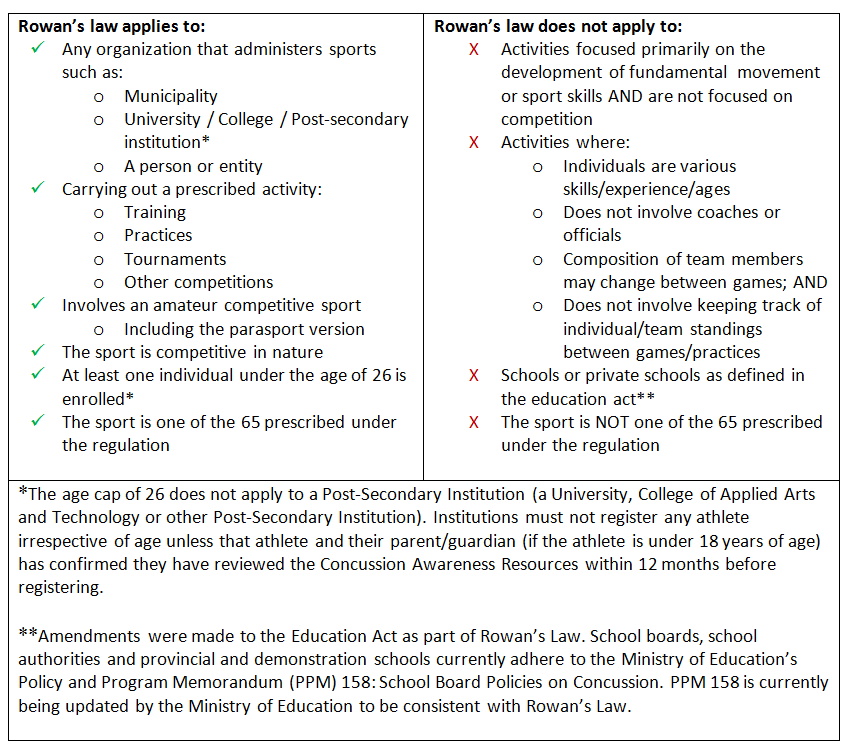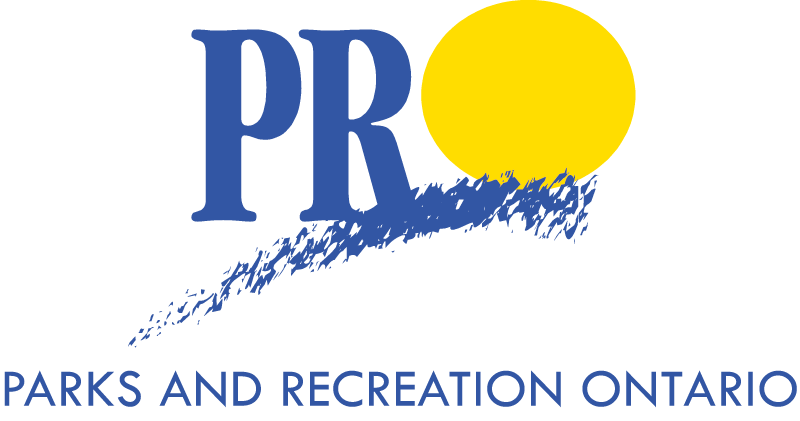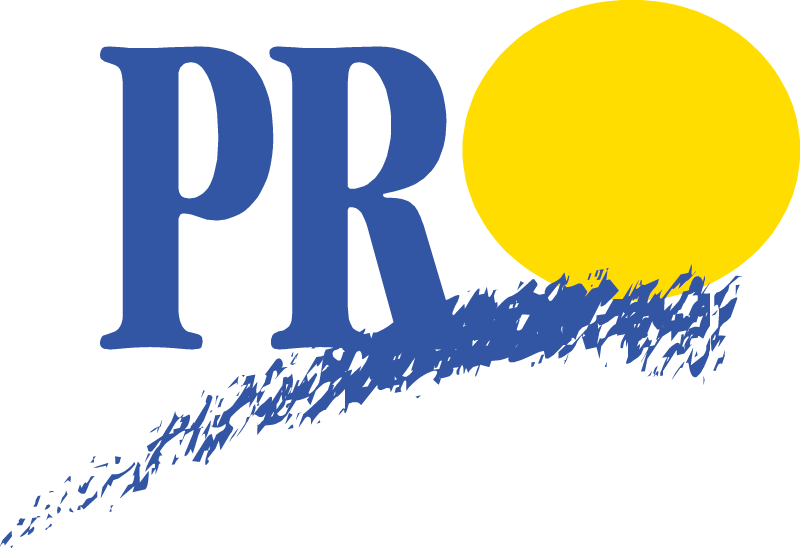
Rowan's Law Regulation comes into effect, July 1, 2019
Important information for municipalities and organizations
Skip to:Possible examples of excluded programs
Possible examples of applicable programs
Rowan's Law requirements
More information and resources
Background
Rowan’s Law (Concussion Safety), 2018, S.O. 2018, c. 1 is intended to enhance safe sport in Ontario through concussion prevention and management.
To support this Act, the government has developed concussion awareness materials for all sports organizations and athletes. These materials will allow all stakeholders involved in sports to better understand the signs and symptoms of a concussion and the required interventions, such as removal from sports and acquiring healthcare, to prevent further injury and possible death of concussed athletes. The act applies to 65 sports listed at the bottom of this page.
Click here for the Act and the Regulations.
Does Rowan's Law apply to you?

• Organizations registering participants who are only above the age of 26 (See note* above)
• Activities which are not focused on competition and/or does not involve coaches/officials.
• Teams where the members change between games.
• Sports that do not involve keeping track of team standings in between games.
• Schools and Private schools (See note** above).
• Organizations that are not incorporated in Ontario that hold competitions in Ontario. However, all organizations that hold competitions in Ontario, regardless of where they are incorporated, must have a Removal-from-sport Protocol and a Return-to-sport Protocol.
• Athletes, coaches or team trainers at a competition in Ontario, who don’t normally reside in Ontario.
• Athletes who are over the age of 26 but are on the same team as athletes under the age of 26. The organization is only required under the act to receive confirmation of review of the resources and code of conduct from the athletes who are under 26, if they are on a team with mixed ages. Athletes who are 26 and over who are on mixed teams are still subject to the protocols of the sport organization.
These exemptions would cover a wide range of recreational programs, such as drop in sports, "learn to" programs, most swim lessons and fundamental movement skills programs. However, municipalities and other recreation providers may have programs that would be considered competitive such as a soccer camp that includes competitive play, some house league play or more advanced training programs focused on a single sport. Any recreation organization should carefully review programs to determine if they need to comply with the act. In some cases, there may be room for interpretation between training an athlete and teaching fundamental sports skills.
Everyone has a role to play in preventing, identifying and managing concussions. The impact of concussions in sport is increasingly seen as a significant issue and we encourage all sport organizations to support concussion safety. The above interpretation and following examples do not constitute legal advice. For guidance, email the Ministry at sport@ontario.ca or seek legal counsel.
Possible Examples of Excluded Programs
The Town offers a weekly, one hour gymnastics program for children aged 4-6. The focus is on learning basic gymnastics skills. There is no competition involved. Excluded because there is no competition and it is focused on fundamental sport skills.
The City runs a youth basketball program. The participants can drop-in to play games. They keep score in games, but don't track team results. There is no coach and the games are self-officiated with only a supervisor present. Excluded because it is informal competition.
The Municipality runs a tee-ball program. The focus is on sport skills and not competition, even though games are played and there are coaches/officials. Results are not tracked. Excluded because the focus is on sport skills.
Examples of Applicable Programs
A non-profit gymnastics club trains children aged 8-10 to prepare them to compete in local meets. They have a coach and the main goal of the activity leads to competition.
Applicable because a) Athletes are under 26 b) They are training for a competition c) Gymnastics is one of the sports designated under the Act.
The City runs a youth basketball program. The participants register, form teams and have a coach present. They work on basketball skills, play games and track results from week to week. The coach acts as an official during game play.
Applicable because a) Athletes are under 26 b) there is a coach c) the standings are tracked game to game deeming it competitive. c) Basketball is one of the sports designated under the Act.
The Town runs a cricket league for athletes aged 21 and over. The teams have player/coaches, officials and they keep track of standings throughout the season. Applicable because:
a) Some athletes may be under 26 b)the standings are tracked game to game deeming it competitive. (However, this could meet the exclusion if no players under the age of 26 were enrolled). c) Cricket is one of the sports designated under the Act.
Rowan's Law Requirements
If Rowan's law applies to your organization, you must meet the following requirements for programs.
Requirement 1: By July 1st 2019, Organizations that meet the above criteria are required to develop and distribute a Concussion Code of Conduct
• Click here for a sample Code of Conduct for Coaches
• Click here for a sample Code of Conduct for Athletes and parent/guardians of athletes under the age of 18
What does the Code of Conduct need to include?
- The chart below indicates what sports organizations are required to establish in a Concussion Code of Conduct. Column 1 indicates the commitment and the check marks indicate who is required to make the commitment or provide acknowledgement of understanding.
- The code of conduct must be reviewed at least annually and updated as soon as possible if any changes are required.
Requirement 2: Organizations must collect confirmation that the following individuals have reviewed a) the Minister approved Concussion Awareness Resources; and b) the Concussion Code of Conduct
• All athletes, under the age of 26, who have registered AFTER July 1, 2019
- • All parents/guardians of athletes who are under the age of 18, who have registered AFTER July 1, 2019
- • All Coaches, team trainers and officials who serve in these positions for activities that include any athlete under age 26
Confirmation of review must be received annually by the individuals listed above.
It is required that the Ministry approved resources are used, regardless of other concussion training that staff or participants may have. Currently there is only a downloadable print copy for different age groups, available for download here. Other formats available soon.
Your organization is responsible for keeping track of confirmations that the required athletes, parent/guardians, coaches and officials have read the materials.
Requirement 3: By July 1, 2020, organizations must develop a Removal-from-Sport and Return-to-Sport Protocol
The Removal-from-sport Protocol must include the following:
- Details of the process to ensure the immediate removal of an athlete who is suspected of having a concussion.
- Identification of a designate and the specific duties of the designated person(s).
|
The duties of the designated person are to: • Immediately remove an athlete from further training, practice or competition if the athlete is suspected of having sustained a concussion (irrespective of where the concussion was/is suspected of being sustained), and for athletes under 18 years of age informing the parent or guardian of the removal.• Call 911 if an athlete is suspected of having a concussion or they believe doing so is necesssary. • Inform the athlete (and parent/guardian) that the athlete is required to undergo a medical assessment by a physician or nurse practitioner before the athlete will be permitted to return to training, practice or competition, according to the Return-to-Sport protocol. |
- Requirement to make and keep a record of all instances of removal from sport.
Not permit an athlete who has been removed from sport to return to training, practice or competition, except in accordance with the sport organization's return-to-sport protocol.
The Return-to-sport Protocol must include the following:
1. Identification of a designate.
• Receive all confirmations from the athlete (or parent/guardian if athlete is under 18 years of age) about the outcome of the athlete’s medical assessment by a physician or nurse practitioner, regarding the status of the athlete’s diagnosis and/or medical clearance to return to unrestricted training, practice or competition. • Inform an athlete who has been diagnosed as having a concussion (or parent/guardian if athlete is under 18 years of age) about the importance of disclosing the diagnosis to any other sport organization with which the athlete is registered, or school that the athlete attends. • Ensure the athlete (or parent or guardian) receives the sports organization's return-to-sport protocol as soon as practical. |
The Act states that the designated person may rely on the information received from an athlete (or parent/guardian if athlete is under 18 years of age) in carrying out the designated person’s responsibilities under a sport organization’s return-to-sport protocol.
- A detailed process that must be followed before an athlete returns to training, practice or competition after an athlete has sustained a concussion or is suspected of having sustained a concussion.
|
The process must include the following: • In all cases, the athlete provides confirmation of medical treatment and diagnosis.• If the athlete has NOT been diagnosed with a concussion AND has been medically cleared by the physician or nurse practitioner, only then can they return to unrestricted practice, training or competition. • If the athlete has been diagnosed with a concussion, the athlete must process through the graduated return-to sport steps. Within the graduated steps, the athlete must be required to: - Share the medical advice or recommendations they receive with a designated The protocol must require the sport organization to:• Not permit an athlete to return to training, practice or competition through the graduated return-to-sport steps unless the athlete, or the athlete's parents or guardian has shared with the designated person the medical advice or recommendations they received. • Inform the athlete, or parents and guardians of an athlete under 18, who has been diagnosed as having a concussion of the importance of disclosing diagnosis to any other sport organization with which the athlete is registered or school that the athlete attends. |

